포경과 포경 수술, Phimosis and Circumcision
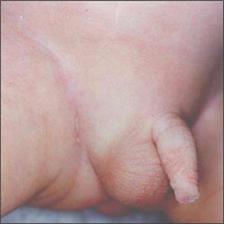
사진 2-25. 정상적으로 귀두는 표피에 꼭 싸여 보호를 받는다. 포경 수술을 받지 않은 정상 자지.
Copyrightⓒ 2011 John Sangwon Lee,MD., FAAP
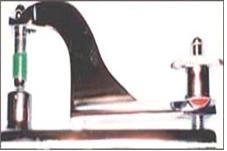
사진 2-23. 포경 수술할 때 쓰는 의료기구.
Copyrightⓒ 2011 John Sangwon Lee, MD., FAAP
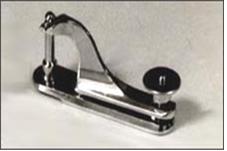
사진 2-24.포경 수술할 때 쓰는 의료기구.
Copyrightⓒ 2011 John Sangwon Lee,MD., FAAP
- 남성의 자지의 끝 부분을 귀두라고 한다.
- 귀두를 둘러싸는 피부를 포피라 하고, 귀두가 포피에 싸여 있는 상태를 포경이라고 한다.
- 포피를 잘라 주는 수술을 포경 수술이라고 한다.
- 신생 남아의 95%에서 자지의 귀두는 포피로 정상적으로 꼭 싸여 있고, 포피의 안쪽 표면은 귀두의 표면에 꼭 붙어 있는 것이 정상이다.
- 남 영유아의 포피는 귀두와 외요구를 보호해 주는 역할을 한다.
- 귀두를 덮고 있는 포피는 귀두의 맨 뒤쪽으로 쉽게 까 젖힐 수 없도록 귀두를 꼭 덮고 있다.
- 초등학교 입학할 때 쯤 10%의 남아들의 귀두가 포피로 꼭 붙어 있고, 17세경 사춘기 남아들의 약 1%의 귀두가 포피로 꼭 덮여 있다.
- 생후 2세까지는 귀두를 덮고 있는 포피를 포경 수술이나 다른 방법으로 까주지 않아도 된다.
- 초등학교 입학 할 때까지 90%의 남아들의 포피는 자연적으로 귀두의 뒤쪽으로 쉽게 까서 젖힐 수 있다.
- 가끔, 포피를 귀두의 맨 뒤쪽으로 쉽게 까서 젖힐 수 없을 때, 대부분의 경우에, 코르티코스테로이드제 연고를 바르면 쉽게 까서 젖힐 수 있다(출처: Pediatrics News August 2008. p.34).
- 미국 성인 남성들의 60∼70%, 캐나다 성인 남성들의 50%가 과거에 포경수술을 받았다.
- 한 연구에 의하면, 포경 수술을 받지 않은 남성들에게는 요로 감염, 음경암, 에이즈, 그 밖의 남성 음경 질병이 더 많이 생긴다.
- 그러나 포경 수술을 받을 때 겪는 고통, 수술비, 출혈, 포경 수술로 인해 생식기에 생기는 감염병 및 여러 가지 합병증을 고려하면, 포경 수술을 통상적으로 하는 것을 삼가야 한다.
- 갓 태어난 신생 남아의 전체의 귀두는 포피로 꼭 싸여 있는 것이 보통이다. 드물게 귀두가 포피로 싸여 있지 않은 상태로 출생하는 신생 남아도 있다.
- 포경 수술을 받지 않은 대부분의 남 신생아들은 일상생활을 할 때나 성인이 된 후 성생활을 즐겁게 하는 데 아무런 지장이 생기지 않는 것이 보통이다.
- 성인이 된 이후 성생활을 시작할 때까지, 남 소아청소년들의 자지의 주 기능은 소변을 보는 것이 고작이다.
- 포피의 주 기능도 성생활을 시작할 때까지 귀두를 잘 싸서 귀두를 보호하는 역할을 한다.
- 드물게, 귀두를 둘러싼 포피의 맨 끝 부분이 서로 꼭 붙어서 심지어는, 포피 오줌 구멍이 비정상적으로 아주 작을 수 있고, 그로 인해 소변을 제대로 보지 못할 수 있다. 그러나 그런 경우는 드물다.
- 이런 경우, 오줌을 정상적으로 누기가 힘들고, 오줌이 한두 방울씩 똑똑 떨어질 수 있고, 오줌줄기가 실 가닥처럼 가늘게 나올 수 있다. 이런 경우, 오줌 포피 구멍을 더 크게 늘려줄 필요가 있다. 핀셋 등으로 꼭 붙은 포피 오줌 구멍을 벌려 늘려 주면, 문제가 곧 바로 잘 해결될 수 있다.
- 그렇게 치료해도 포피 오줌 구멍이 너무 작아서 오줌을 잘 누지 못하면, 포경 수술 치료를 받는다. [부모도 반의사가 되어야 한다-소아가정간호백과]-제 6권 신생아 성장 발육 양호 및 질환 -신생아의 외음 참조.
- 갓 태어나서부터 초등학교에 입학할 때까지 대부분의 남 영유아의 귀두는 정상적으로 포피로 둘러싸여 있다. 이런 남아의 포피를 일부러 손으로 벗겨 까줄 필요도 없다.
- 특히 태어날 때부터 가지고 있는 아들의 개인적인 신체 부분은 그의 부모이든 누구이든 함부로 만지거나 까서도 안 된다.
- 5, 6세쯤 된 남 유아들의 포피의 안쪽 면 점액층에서 하얀 치즈 비슷한 분비물이 나오기 시작하는데, 이 분비물을 치구라고 한다.
- 치구가 분비되기 시작하면서 포피는 귀두의 표면층으로부터 자연히 분리되기 시작한다.
- 이런 분비물은 포피가 귀두에서 쉽게 분리될 수 있게 보습제와 윤활제 역할을 한다.
- 그래서 귀두를 촉촉하게 만들고 부드럽고 윤활하게 만든다. 초등학교에 입학할 때쯤 남아들의 10%에서는 포피가 귀두에서 쉽게 벗겨지지 않는다고 전술 했다.
- 학령기 남아들이 점점 더 성장하여 사춘기에 접어들면, 치구가 더욱 풍부하게 분비되고 자지가 성인의 자지처럼 커진다.
- 이런 자연 생리현상은 성교 예상 상대자의 질에서 성교를 쉽게 할 수 있게 질 분비물이 충분히 나오지 않아서 성관계를 쉽게 할 준비가 되어 있지 않더라도, 남성의 귀두를 싼 표피에서 분비되는 윤활제로 성관계를 시작하기가 훨씬 쉬워진다.
- 성교를 할 때는 포피가 자연적으로 귀두에서 쉽게 벗겨지는 것이 보통이다.
- 사춘기 되기 바로 전후 귀두를 꼭 둘러 싼 포피를 손으로 거의 100% 벗겨 젖힐 수 있는 것이 보통이다.
- 사춘기 이후에도 포피가 자연적으로 뒤로 젖혀지지 않거나 손으로 쉽게 젖힐 수 없을 때, 완전 포경이라고 한다.
- 이런 완전 포경 경우, 포경 수술 치료를 받아야 한다.
- 신생 남아에게 포경 수술을 하는 것에 대해 의학계에서는 아직도 찬반양론이 분분하다.
- 이런 논쟁은 끝이 없이 계속될 것이다.
- 신생아기 때 포경 수술을 받지 않은 소아청소년 남아들은 포경 수술을 받은 남아들보다 자지나 자지 이외 비뇨기계통 어디에 질병이 더 많이 생길 수 있다는 연구도 있다.
- 그렇지만 그 결과에 대해서도 찬반양론이 많다. [부모도 반의사가 되어야 한다-소아가정간호백과]-제 6권 신생아 성장 발육 양호 및 질환 포경 수술한 신생 남아의 잠지를 어떻게 간호해 주나요? 참조.
- 소아청소년 자녀들의 경우, 포경 수술을 받지 않았기 때문에 귀두를 싸고 있는 포피를 일부러 손으로 뒤로 젖히고 귀두를 닦아줄 필요는 없다. 자지에 특별한 병이 생기지 않는 한, 포경 수술을 꼭 할 필요는 없고, 귀두를 둘러싼 포피를 일부러 뒤로 젖히고 귀두와 포피 안쪽을 꼭 닦아 줄 필요도 없다.
- 포경 수술을 하는 이유에는 의학적인 이유도 가끔 있지만, 대부분의 경우에는 유행이나 종교적인 이유 때문이다.
- 저자는 어렸을 때 익지 않은 밤송이를 강제로 까서 밤알을 떼어 냈던 것을 생각하면서, 귀두에 꼭 붙은 표피를 포경 수술로 떼어내는 포경수술 과정과 비교해 환아 부모들에게 설명해 주기도 한다.
- 밤은 익으면 밤송이 속에서 쉽게 떨어진다.
- 세계 최초 육아지침서 저자인 닥터 스포크스 박사는 최초에 그의 저서에서 “My grand son’s little penis(“내 손자의 그 작은 자지)는 있는 그대로 놓아두었다.”라고 했다.

사진 2-25. 귀두가 표피에 꼭 싸여 보호를 받는다. 포경 수술을 받지 않은 정상적인 자지.
Copyrightⓒ 2011 John Sangwon Lee, MD., FAAP
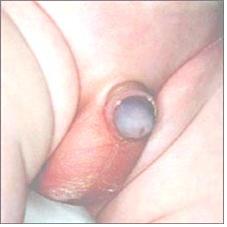
사진 2-26. 포경 수술을 받은 자지. 표피가 없으므로 귀두는 항상 건조하고 윤활하지 않은 상태로 있다.
Copyrightⓒ 2011 John Sangwon Lee, MD., FAAP
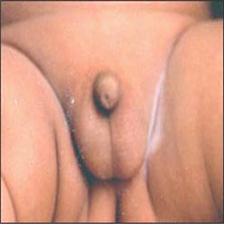
사진 2-27. 포경 수술을 받지 않은 남 유아의 정상적인 자지.
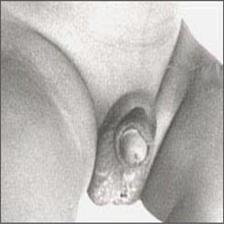
Copyrightⓒ 2011 John Sangwon Lee, MD., FAAP
사진 2-28. 포경 수술을 받은 자지. 포경 수술을 받은 자지는 성교할 때 성감이 덜할 수 있다거나 더 좋을 수 있다는 논쟁이 있지만, 두 가지 경우의 음경을 다 가지고 있는 남성은 없기 때문에, 연구 결과는 없을 것이다.
Copyrightⓒ 2011 John Sangwon Lee, MD., FAAP
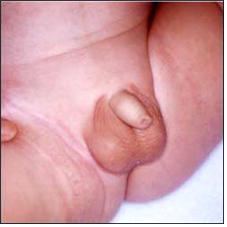
사진 2-29. 정상적인 영아 자지.
Copyrightⓒ 2011 John Sangwon Lee, MD., FAAP
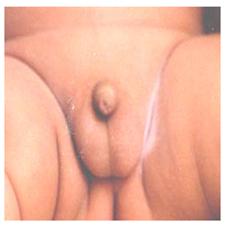
사진334.포경수술을 받지 않은 정상인 신생아의 자지
Copyrightⓒ 2011 John Sangwon Lee, MD., FAAP
Phimosis and Circumcision

Photo 2-25. Normally, the glans is protected by the epidermis. A normal, uncircumcised penis. Copyrightⓒ 2011 John Sangwon Lee, MD., FAAP

Picture 2-23. A medical device used during circumcision. Copyrightⓒ 2011 John Sangwon Lee, MD., FAAP

Picture 2-24. Medical instruments used for circumcision. Copyrightⓒ 2011 John Sangwon Lee, MD., FAAP
• The tip of a man’s penis is called the glans.
• The skin surrounding the glans is called foreskin, and the condition in which the glans is wrapped in the foreskin is called phimosis.
• Surgery to cut the foreskin is called circumcision.
• In 95% of newborn boys, the glans of the penis is normally covered with the foreskin, and the inner surface of the foreskin is normally attached to the surface of the glans.
• Male infants’ foreskin protects the glans and external demands
. • The foreskin covering the glans tightly covers the glans so that it cannot be easily removed to the back of the glans.
• By the time they enter elementary school, the glans of 10% of boys are covered with the foreskin, and by the age of 17, about 1% of boys in puberty are covered with the foreskin
. • Until 2 years of age, the foreskin covering the glans does not need to be circumcised or otherwise removed.
• By the time they enter elementary school, the foreskin of 90% of boys can be easily peeled off the back of the glans penis.
• Occasionally, when the foreskin cannot be easily peeled off the back of the glans, in most cases, it can be easily peeled off by applying a corticosteroid ointment (Source: Pediatrics News August 2008. p.34).
• 60% to 70% of adult males in the United States and 50% of adult males in Canada have been circumcised in the past.
• One study found that uncircumcised men were more likely to develop urinary tract infections, penile cancer, AIDS, and other male penile diseases.
• However, considering the pain, cost of surgery, bleeding, infectious diseases of the genital organs and various complications caused by circumcision, circumcision should not be routinely performed.
• The entire glans of a newborn baby boy is usually covered with a foreskin. Rarely, some newborn boys are born with the glans not covered by the foreskin.
• Most uncircumcised newborn males do not normally have any problems with enjoying their sex life during normal activities or into adulthood.
• From adulthood until sexual activity begins, the primary function of the penis in male children and adolescents is to urinate.
• The main function of the foreskin is to protect the glans by wrapping it well until the start of sexual life.
• Rarely, the very tips of the foreskin surrounding the glans cling to each other and even the foreskin urinal may be abnormally small, resulting in difficulty urinating. But that is rarely the case.
• In this case, it may be difficult to urinate normally, urine may drip one or two drops, and the urine stream may come out as thin as a strand of thread. In this case, it is necessary to enlarge the urinary foreskin orifice. If you use tweezers, etc., to open and lengthen the tight foreskin pee hole, the problem can be solved right away.
• If the foreskin pee hole is too small to urinate even after such treatment, circumcision is performed. www.drleepediatrics.com – Volume 6 Good growth and development of newborns and diseases -Refer to the vulva of a newborn.
• From birth to entering elementary school, most boys’ glans are normally surrounded by the foreskin. There is no need to intentionally remove the foreskin of this boy by the hand.
• In particular, the son’s personal body parts, which he has been carrying since birth, should not be touched or removed by anyone, whether his or her parents.
• In boys around the age of 5 or 6 years old, white, cheese-like secretions begin to come out of the inner mucous layer of the foreskin. This secretion is called jigu.
• As the jig begins to be secreted, the foreskin naturally begins to separate from the surface layer of the glans.
• These secretions act as a moisturizer and lubricant to allow the foreskin to detach from the glans easily.
• So it moisturizes the glans and makes it soft and lubricated. By the time they entered elementary school, 10% of boys stated that the foreskin did not come off easily from the glans.
• As school-age boys grow older and enter puberty, the jigs are secreted more abundantly and their penises grow like those of adults.
• This natural physiological phenomenon makes it difficult to start sexual intercourse with the lubricant secreted from the epidermis of the male glans, even if the person is not ready for sexual intercourse because the vaginal secretions are not produced enough to facilitate intercourse Much easier.
• It is normal for the foreskin to naturally peel off the glans easily during intercourse.
• It is normal to be able to peel off almost 100% of the foreskin that surrounds the glans by hand just before or after puberty.
• When the foreskin does not retract naturally or cannot be retracted easily by hand after puberty, it is called complete circumcision.
• In this case of total circumcision, circumcision should be treated.
• The medical community is still divided against the pros and cons of circumcision on newborn boys. • This debate will go on without end.
• Studies have shown that children and adolescents who are not circumcised during their neonatal period are more likely to develop diseases in the penis or other parts of the urinary system than those who are circumcised.
• However, there are many pros and cons about the results. www.drleepediatrics.com – Volume 6 Newborn Growth and Development Good and Diseases How do you care for the young boys of a circumcised newborn boy? reference.
• In the case of children and adolescents, since they are not circumcised, there is no need to deliberately tilt the foreskin covering the glans back and clean the glans. Unless there is a special disease on the penis, circumcision is not necessary, and there is no need to intentionally tilt the foreskin surrounding the glans back and wipe the glans and the inside of the foreskin.
• Circumcision is sometimes done for medical reasons, but in most cases it is for fashionable or religious reasons.
• The author also explains to the parents of sick children compared to the process of circumcision, which removes the epidermis attached to the glans, by forcibly peeling chestnuts when they were young.
• Chestnuts fall easily in chestnut clusters when ripe.
• Dr. Spokes, author of the world’s first parenting guide, first said in his book, “My grand son’s little penis was left as it was.”

Photo 2-25. The glans is tightly wrapped in the epidermis and protected. A normal, uncircumcised penis. Copyrightⓒ 2011 John Sangwon Lee, MD., FAAP

Picture 2-26. A penis that was circumcised. Since there is no epidermis, the glans is always dry and unlubricated. Copyrightⓒ 2011 John Sangwon Lee, MD., FAAP

Picture 2-27. Normal penis of an uncircumcised male infant. Copyrightⓒ 2011 John Sangwon Lee, MD., FAAP

Picture 2-28. A penis that was circumcised. There is some debate that circumcised cocks can be less or better for intercourse, but since no men have both types of penises, there will be no results from the study. Copyrightⓒ 2011 John Sangwon Lee, MD., FAAP

Picture 2-29. Normal infant cock. Copyrightⓒ 2011 John Sangwon Lee, MD., FAAP

Picture 334. Cock of a normal uncircumcised newborn Copyrightⓒ 2011 John Sangwon Lee, MD., FAAP
출처 및 참조 문헌 Sources and references
- NelsonTextbook of Pediatrics 22ND Ed
- The Harriet Lane Handbook 22ND Ed
- Growth and development of the children
- Red Book 32nd Ed 2021-2024
- Neonatal Resuscitation, American Academy Pediatrics
- www.drleepediatrics.com 제1권 소아청소년 응급 의료
- www.drleepediatrics.com 제2권 소아청소년 예방
- www.drleepediatrics.com 제3권 소아청소년 성장 발육 육아
- www.drleepediatrics.com 제4권 모유,모유수유, 이유
- www.drleepediatrics.com 제5권 인공영양, 우유, 이유식, 비타민, 미네랄, 단백질, 탄수화물, 지방
- www.drleepediatrics.com 제6권 신생아 성장 발육 육아 질병
- www.drleepediatrics.com제7권 소아청소년 감염병
- www.drleepediatrics.com제8권 소아청소년 호흡기 질환
- www.drleepediatrics.com제9권 소아청소년 소화기 질환
- www.drleepediatrics.com제10권. 소아청소년 신장 비뇨 생식기 질환
- www.drleepediatrics.com제11권. 소아청소년 심장 혈관계 질환
- www.drleepediatrics.com제12권. 소아청소년 신경 정신 질환, 행동 수면 문제
- www.drleepediatrics.com제13권. 소아청소년 혈액, 림프, 종양 질환
- www.drleepediatrics.com제14권. 소아청소년 내분비, 유전, 염색체, 대사, 희귀병
- www.drleepediatrics.com제15권. 소아청소년 알레르기, 자가 면역질환
- www.drleepediatrics.com제16권. 소아청소년 정형외과 질환
- www.drleepediatrics.com제17권. 소아청소년 피부 질환
- www.drleepediatrics.com제18권. 소아청소년 이비인후(귀 코 인두 후두) 질환
- www.drleepediatrics.com제19권. 소아청소년 안과 (눈)질환
- www.drleepediatrics.com 제20권 소아청소년 이 (치아)질환
- www.drleepediatrics.com 제21권 소아청소년 가정 학교 간호
- www.drleepediatrics.com 제22권 아들 딸 이렇게 사랑해 키우세요
- www.drleepediatrics.com 제23권 사춘기 아이들의 성장 발육 질병
- www.drleepediatrics.com 제24권 소아청소년 성교육
- www.drleepediatrics.com 제25권 임신, 분만, 출산, 신생아 돌보기
- Red book 29th-31st edition 2021
- Nelson Text Book of Pediatrics 19th- 21st Edition
- The Johns Hopkins Hospital, The Harriet Lane Handbook, 22nd edition
- 응급환자관리 정담미디어
- Pediatric Nutritional Handbook American Academy of Pediatrics
- 소아가정간호백과–부모도 반의사가 되어야 한다, 이상원 저
- The pregnancy Bible. By Joan stone, MD. Keith Eddleman, MD
- Neonatology Jeffrey J. Pomerance, C. Joan Richardson
- Preparation for Birth. Beverly Savage and Dianna Smith
- 임신에서 신생아 돌보기까지. 이상원
- Breastfeeding. by Ruth Lawrence and Robert Lawrence
- Sources and references on Growth, Development, Cares, and Diseases of Newborn Infants
- Emergency Medical Service for Children, By Ross Lab. May 1989. p.10
- Emergency care, Harvey Grant and Robert Murray
- Emergency Care Transportation of Sick and Injured American Academy of Orthopaedic Surgeons
- Emergency Pediatrics A Guide to Ambulatory Care, Roger M. Barkin, Peter Rosen
- Quick Reference To Pediatric Emergencies, Delmer J. Pascoe, M.D., Moses Grossman, M.D. with 26 contributors
- Neonatal resuscitation Ameican academy of pediatrics
- Pediatric Nutritional Handbook American Academy of Pediatrics
- Pediatric Resuscitation Pediatric Clinics of North America, Stephen M. Schexnayder, M.D.
-
Pediatric Critical Care, Pediatric Clinics of North America, James P. Orlowski, M.D.
-
Preparation for Birth. Beverly Savage and Dianna Smith
-
Infectious disease of children, Saul Krugman, Samuel L Katz, Ann A.
- 제4권 모유, 모유수유, 이유 참조문헌 및 출처
- 제5권 인공영양, 우유, 이유, 비타민, 단백질, 지방 탄수 화물 참조문헌 및 출처
- 제6권 신생아 성장발육 양호 질병 참조문헌 및 출처
- 소아과학 대한교과서
-
의학 용어사전 대한 의사 협회
-
그 외
Copyright ⓒ 2014 John Sangwon Lee, MD, FAAP
“부모도 반의사가 되어야 한다”-내용은 여러분들의 의사로부터 얻은 정보와 진료를 대신할 수 없습니다.
“The information contained in this publication should not be used as a substitute for the medical care and advice of your doctor. There may be variations in treatment that your doctor may recommend based on individual facts and circumstances.
“Parental education is the best medicine.